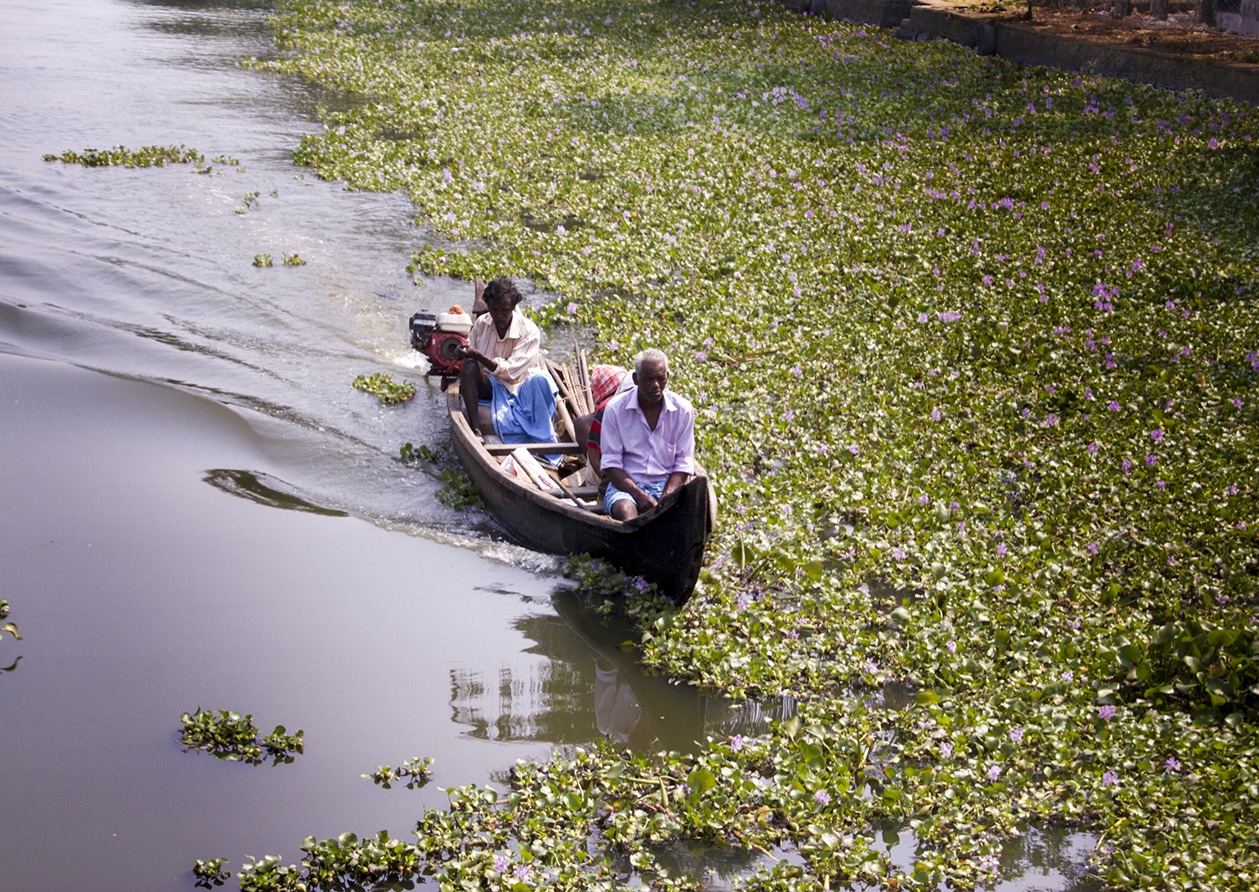Magazine
Like Water For Kerala

The backwaters, famous in tourism literature, really aren’t that “back” or secluded at all.
There are backwaters and then there are backwaters, an entire hidden river system teaming with life that you won’t find on any poster or the pages of a magazine. From our low flat boat, we boarded one smaller and gently glided through the narrow rivulets and channels, taking in the bright tropical foliage, coconut palms and soft leafy vines spilling over the waters edge. The backwaters are a river by another name, unless you see their intimate counterpart; these are the quiet, tranquil waterways, so still that when the boatsman cuts through the surface, the soft thick ripples make the water look like a bolt of silk rolled open.
Floating along in the stillness it occurs to me that I’ve really lost my connection with nature. We can hardly go 15 minutes without checking our phone, I don’t eat fallen fruit or wear rope sandals, and except for happiness, my life is largely synthetic. But here on the off-the-beaten track waterways there is a simple life that beats in harmony with nature’s overflowing basket of abundance. We found tapioca trees growing wildly, cashew trees with their pretty bloom of crescent shaped nuts, and palms that yield 40-50 coconuts every few months. Rhythmically picked and stored, these coconuts roll through the seasons as needed, some for their sweet fresh pulp to make coconut paste or oil and others stored and soaked in water so that every six months they’ll be ready to weave mats, ropes and baskets for villagers.
When we edged alongside the riverbank at the village of Poothotta, home to just a handful of families, a chubby little face greeted us with smiling eyes and wide toothless grin. In the dimly lit kitchen, she stood on the uneven concrete floor, clattering pans and occasionally dipping her fingers into a bowl of Upma with little black mustard seeds wedged in the soft dough.
The kitchen had one light bulb swinging on a long wire over the stove where dried palms and twigs are stored during the long monsoon. We soon learnt this woman is the backbone of the village, turning her hands deftly to select a soft water-filled coconut and beating it against a slab of wood. Within minutes she was ringing out cupfuls of water and collecting the wiry coconut fibers in a bunch and stuffing them down the front of her checkered sari. As she plucked out the husks and began twisting them, the loose fibers took shape as finely woven strands, which she then tied around an old iron spinning wheel and within moments meters of tightly woven rope appeared.
Watching her barefoot and smiling as she crafted rope on the soft mud, her young granddaughters appeared, smiling at us and singing songs. We were drawn by their melodious voices and short, cropped hair, framing their cheerful brown eyes, while they seemed curious that the coconut twines their grandmother was spinning matched Lee’s hair. We walked around the village as villagers pointed out little plants with the strength to heal kidney stones and cashew tree twigs used for underwater fishing nets as their warmth in the cooler winter months attract fish.
Nothing goes waste, nothing that nature hasn’t thought of. As we sat sipping pepper tea on the riverbank, we wondered what disconnected life we had manufactured and pondered that maybe we’re the ones who have wondered off track.
We climbed gingerly back into the low flatboats and I couldn’t imagine a prettier boat ride; white cranes flying overhead, fat jellyfish bobbing alongside us, cool water, surprisingly so clear that when our guide collected it in an empty bottle, we put ours aside afraid we might likely mix them up.
South India is another world from the parched dusty north. Across Kerala, the government provides clean drinking water, the literacy rate is near 100 percent, newlyweds go to the wife’s house not the other way around and somehow this sort of social sophistication makes life in the city of Cochin, or even this little village, feel different. It seems our staunch little chubby coconut weaving, specialty local chef, entrepreneur and matriarch of the village really is just that. Oh, and her name means “sun,” with a happy heart and smile just as wide.
We were told that Kerala is a land of contradictions — Fort Cochin has no Fort, the well known garden of flowers has no flowers and when our guide teasingly asked us if we’d heard about crocodile pond and we said, “what, no crocodiles?” he retorted “no pond!”
I’d say the same for the backwaters. Wherever the water carries you, you’re hugged by their generous calming spirit. The backwaters, famous in tourism literature, really aren’t that “back” or secluded at all. The real adventure begins on the hidden waterways, where little streams carve their way through fields of palm trees, full of broad green leaves immersed in the water. The forest tells of lightening strikes, of heavy monsoons, of seasons of abundance and surrender. Mostly it tells the story of nature’s harmony, to people open to listening.
